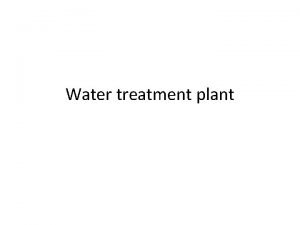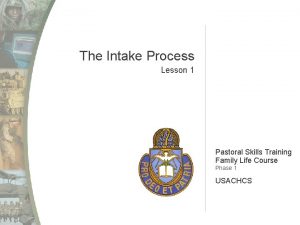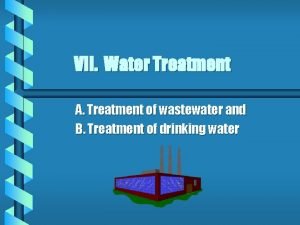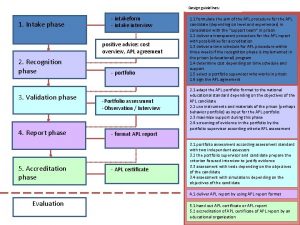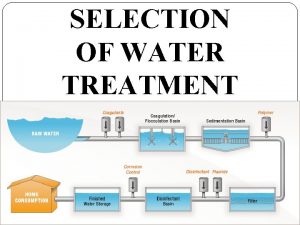CHAPTER 4 Water Treatment Process Water Intake Part













- Slides: 13

CHAPTER 4: Water Treatment Process: Water Intake (Part II) Dr Abdul Haqi Water Research Group (WAREG)

Example 1 A two-cell intake tower located in a cold climate reservoir is being designed for a winter design flow rate of 6, 000 m 3 /d. The tower will have three ports at three different elevations in each cell. Each port must be able to deliver the design flow rate operating alone. Determine the area of each port opening.

For a cold climate reservoir, the intake velocity should be limited to less than 0. 10 m/s ( Table 3 -4 ). Using an intake velocity of 0. 08 m/s and Equation 3 -1:

Example 2 Revise the area estimate made in Example 3 -1 to take into account the area occupied by a bar rack with a clear opening of 4 cm and a bar 1 cm in width. Assume that the opening is a square.

DESIGN CREATERIA: CONDUIT – either a tunnel or a pipeline. – Generally, it is designed to flow by gravity. – to carry the maximum design flow rate – To minimize the accumulation of sediment the flow velocity should be greater than 1 m/s

DESIGN CREATERIA: CONDUIT Hazen-Williams equation is the one most commonly used to describe the flow of water in pipes. Q = 0. 278 CD 2. 63 S 0. 54 – Where – Q flow rate, m 3 /s – C Hazen-Williams coefficient of roughness – D diameter of pipe, m – S slope of energy grade line, m/m

DESIGN CREATERIA: CONDUIT: EXAMPLE

Examples – Determine the diameter of a concrete conduit to transport the water from the intake tower described Example 3 -1 to a low-lift pump station on shore. From Table 3 -3 , the maximum flow rate is assumed to be 2. 0( Q ), that is, twice the winter design flow rate. A sketch of the minimum lake elevation and the maximum allowable drawdown in the low-lift pump station is shown below.

SOLUTION – From Example 3 -1, the winter design flow rate is 6, 000 m 3/d. The maximum flow rate is: 2. 0(Q) = (6, 000 m 3/d) = 12, 000 m 3/d. - Use Hazen-Williams equation to find pipe diameter, D. Q = 0. 278 CD 2. 63 S 0. 54 - Convert Q to appropriate units:

– Because of the very long life expectancy for the conduit, from Appendix C, select a very conservative C = 80 for concrete pipe. The slope in appropriate units is 0. 3 m/100 m = 0. 003 m/m). – Answer D = 0. 479 m, choose 0. 5 m

SHORE INTAKE: LOCATION – minimum water depth for a shore intake should be about 2 m. – outside bank of an established river bend is preferred

SHORE INTAKE: INTAKE BAY – The structure should be divided into two or more independent inlets to provide redundancy. – The inlet velocity may be as high as 0. 5 m/s in warm climates but should be reduced to 0. 3 m/s or less if large amounts of debris are expected

SHORE INTAKE: SCREEN – Trash racks are used to remove large objects – fine screens to protect the pumps – maximum head loss from clogging of the trash racks should be limited to between 0. 75 and 1. 5 m.
 Intake water treatment process
Intake water treatment process Zeta national prayer
Zeta national prayer Ground water treatment process
Ground water treatment process Lime soda process of water softening
Lime soda process of water softening Water treatment process
Water treatment process Water and water and water water
Water and water and water water Pmo project intake process
Pmo project intake process Demand management platform
Demand management platform Alpha kappa alpha membership intake process manual
Alpha kappa alpha membership intake process manual Alpha kappa alpha membership intake process manual
Alpha kappa alpha membership intake process manual Training intake process
Training intake process Project intake process presentation
Project intake process presentation Wastewater treatment process primary secondary tertiary
Wastewater treatment process primary secondary tertiary Normalizing adalah
Normalizing adalah




